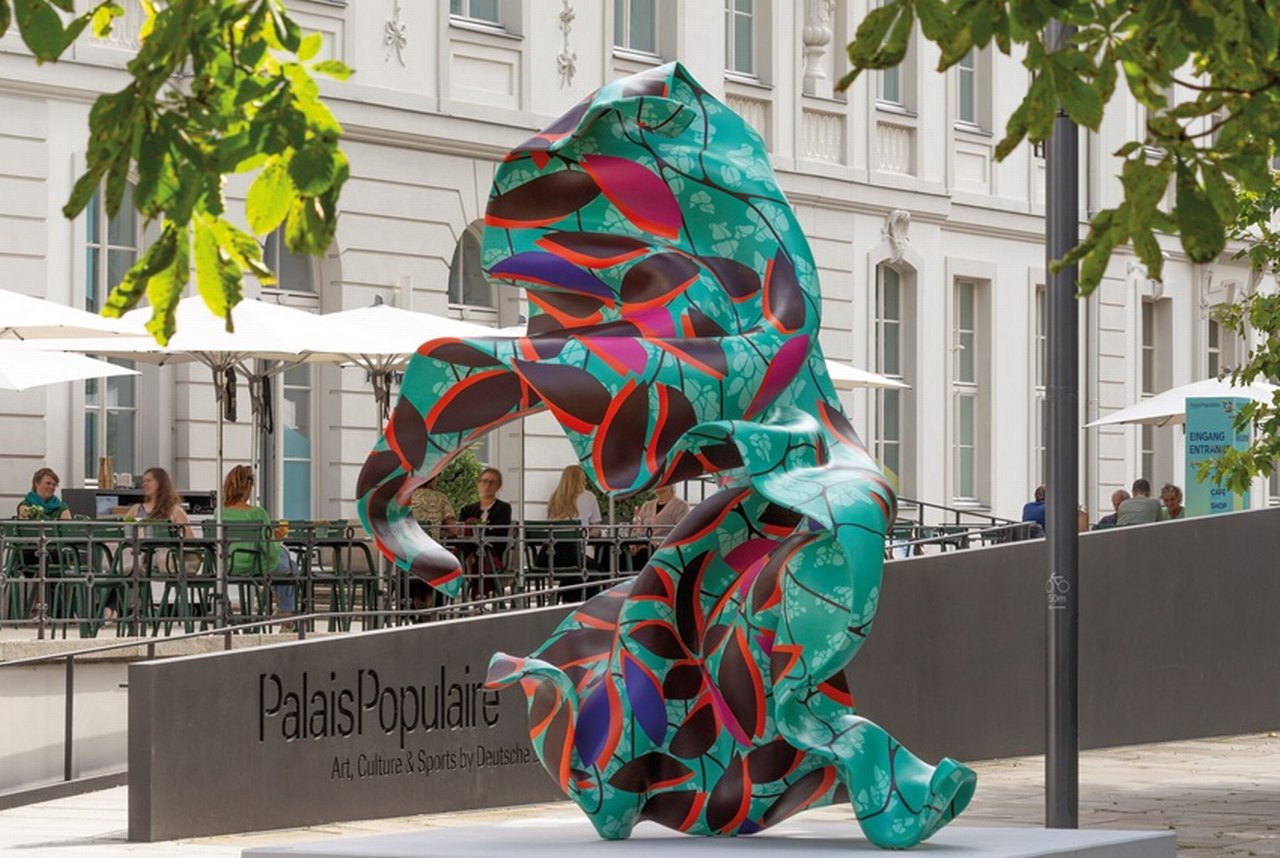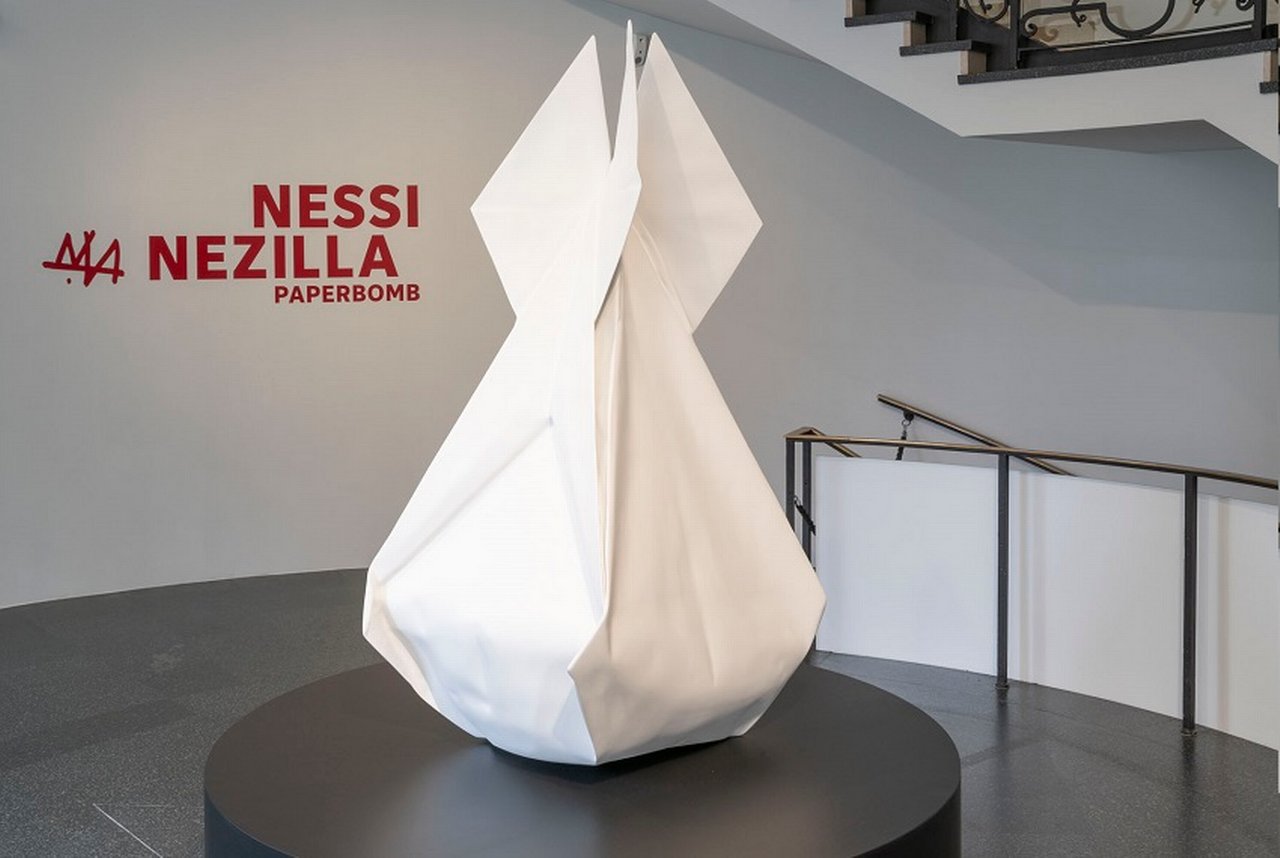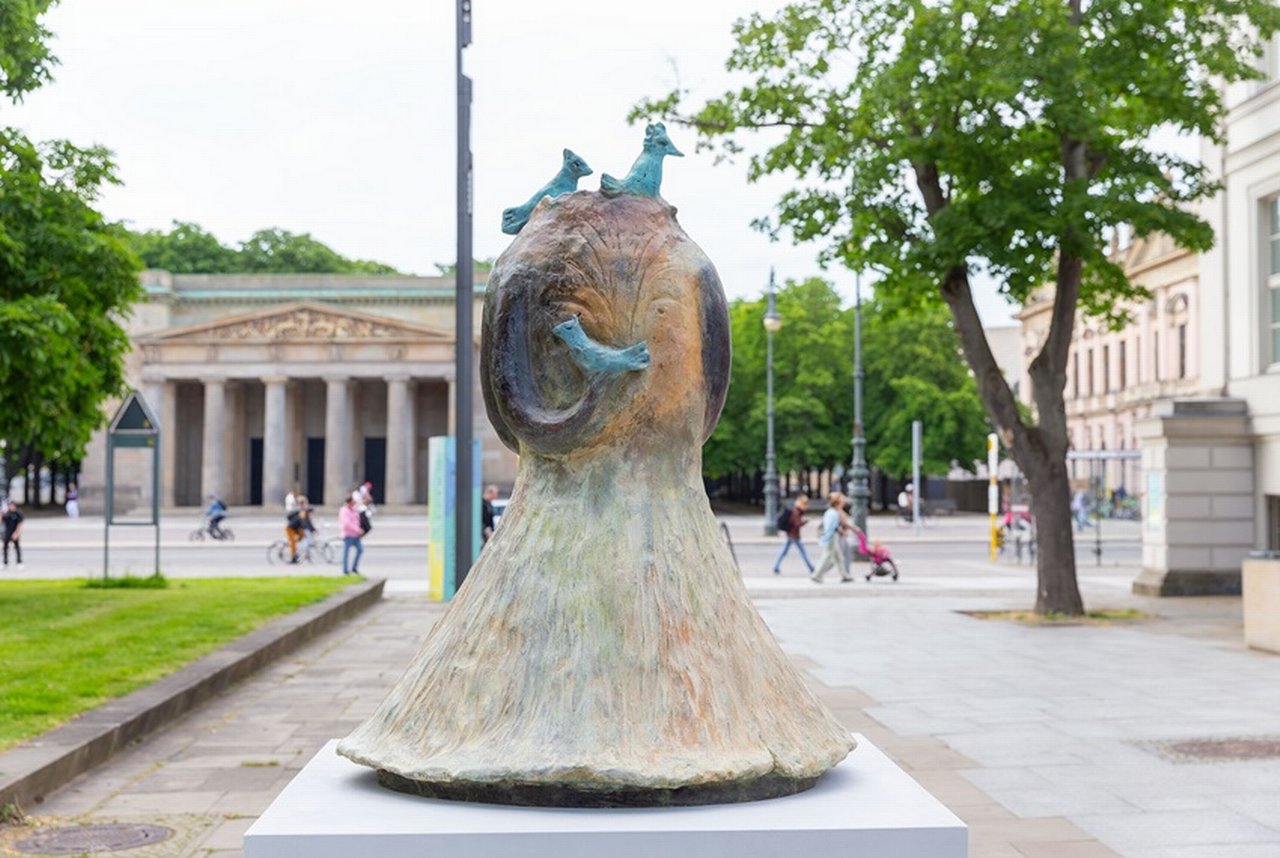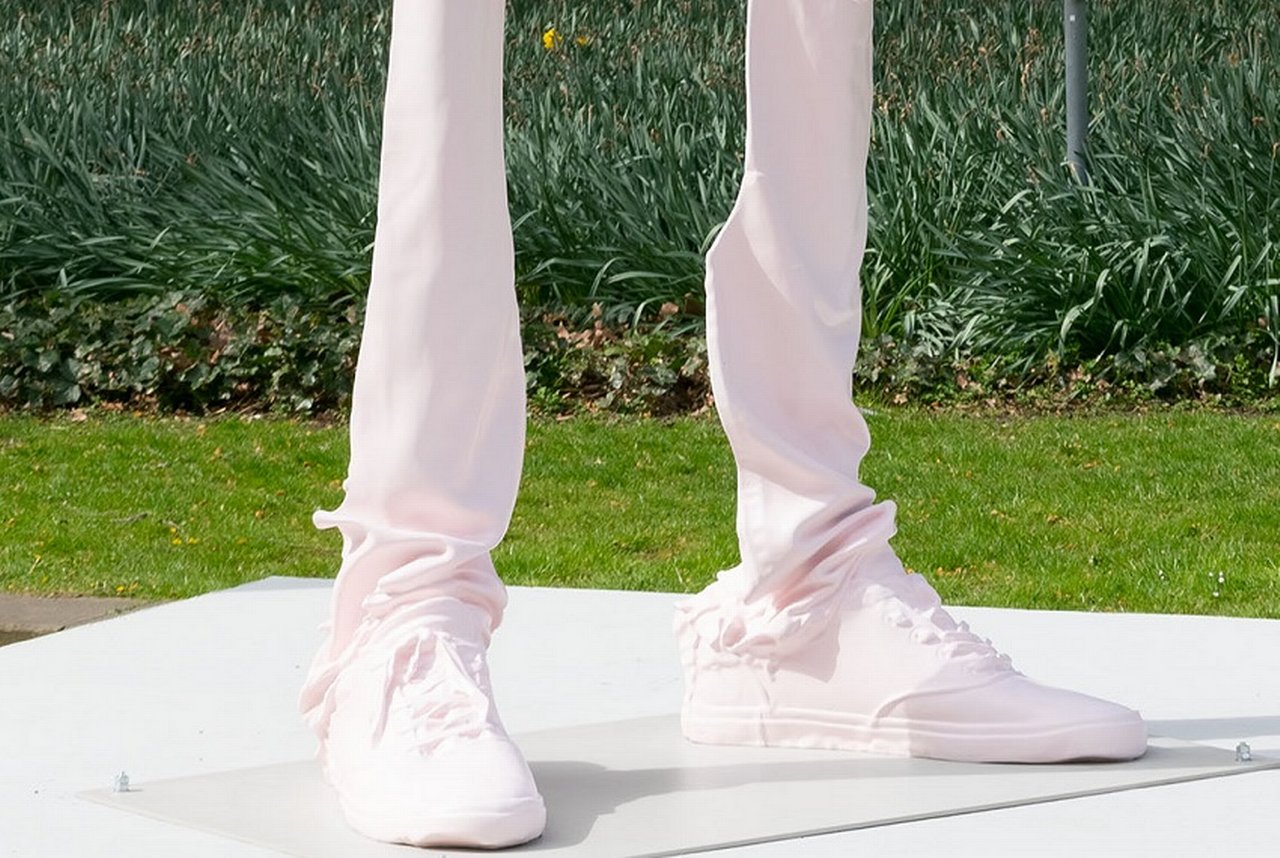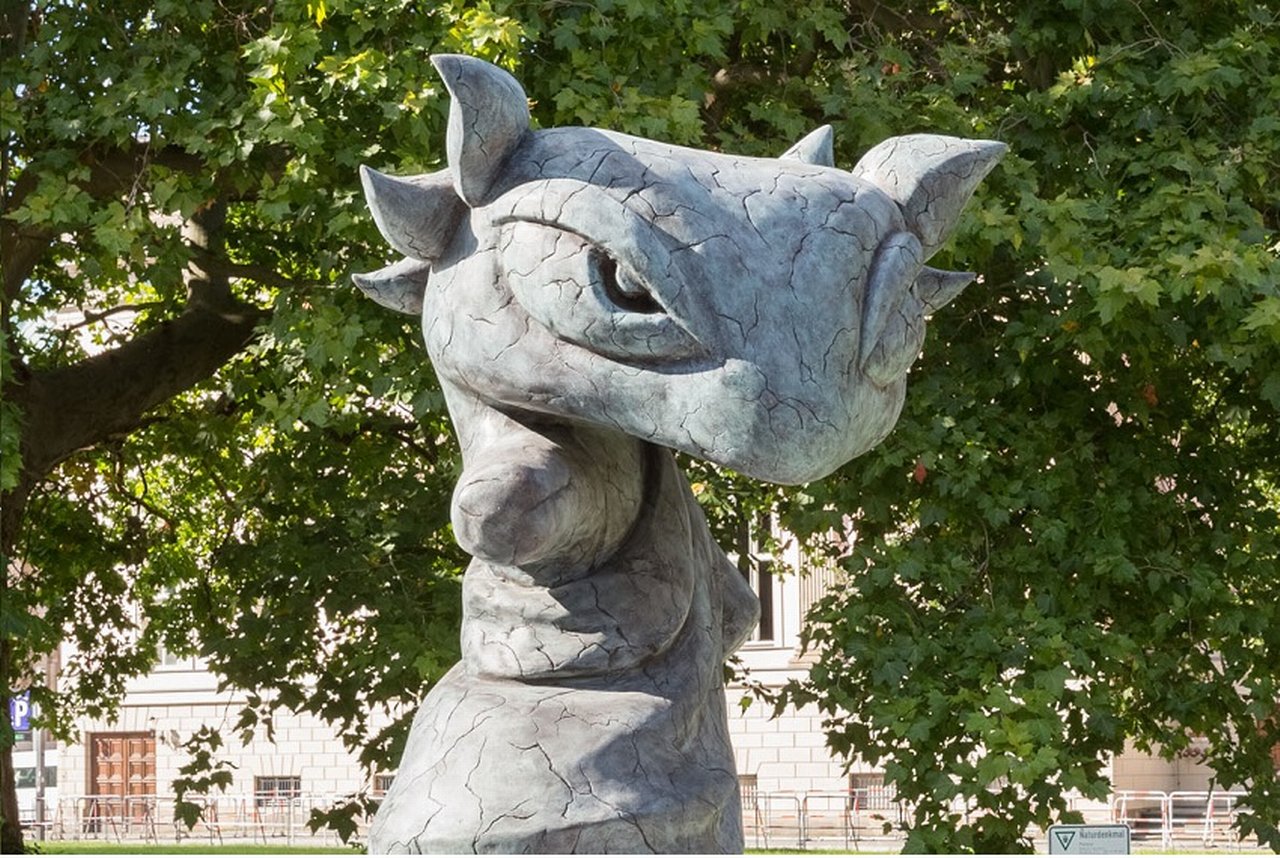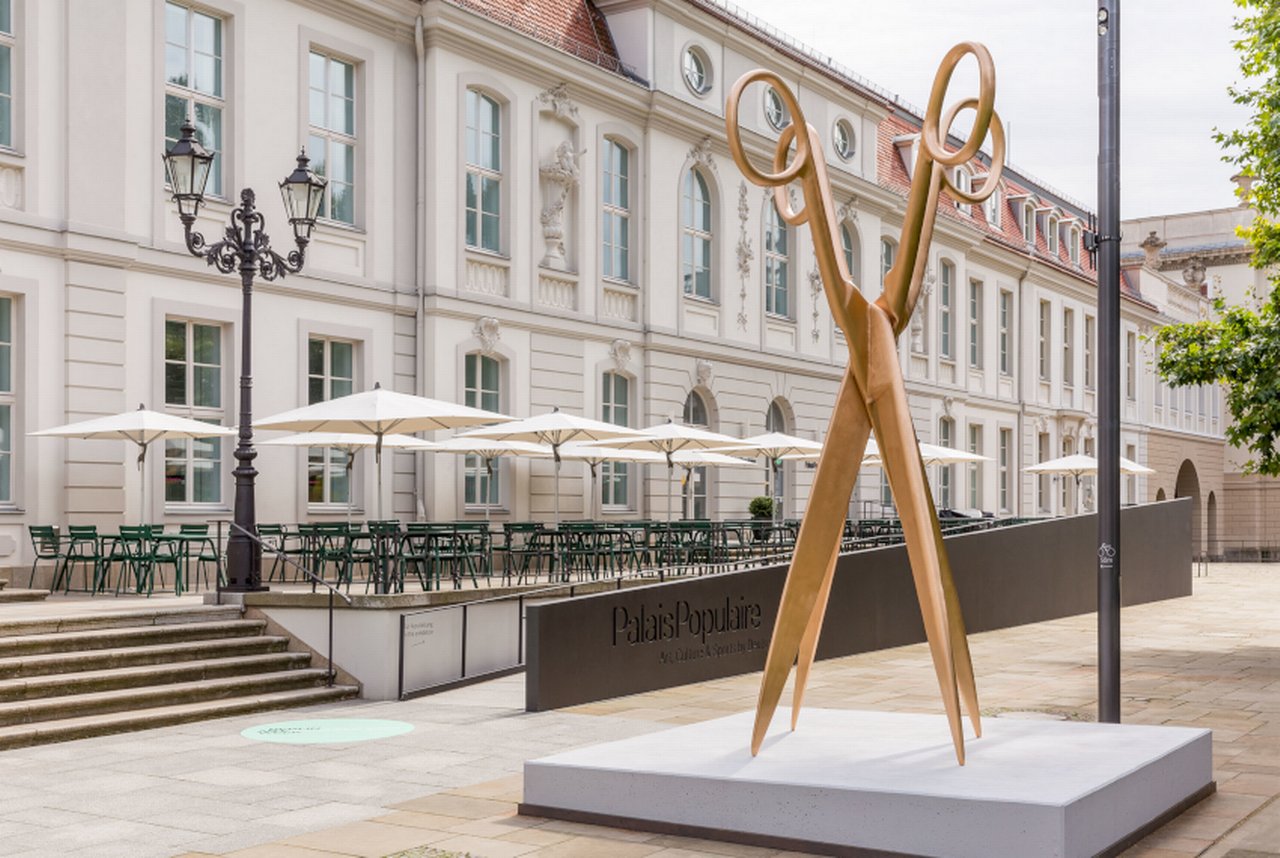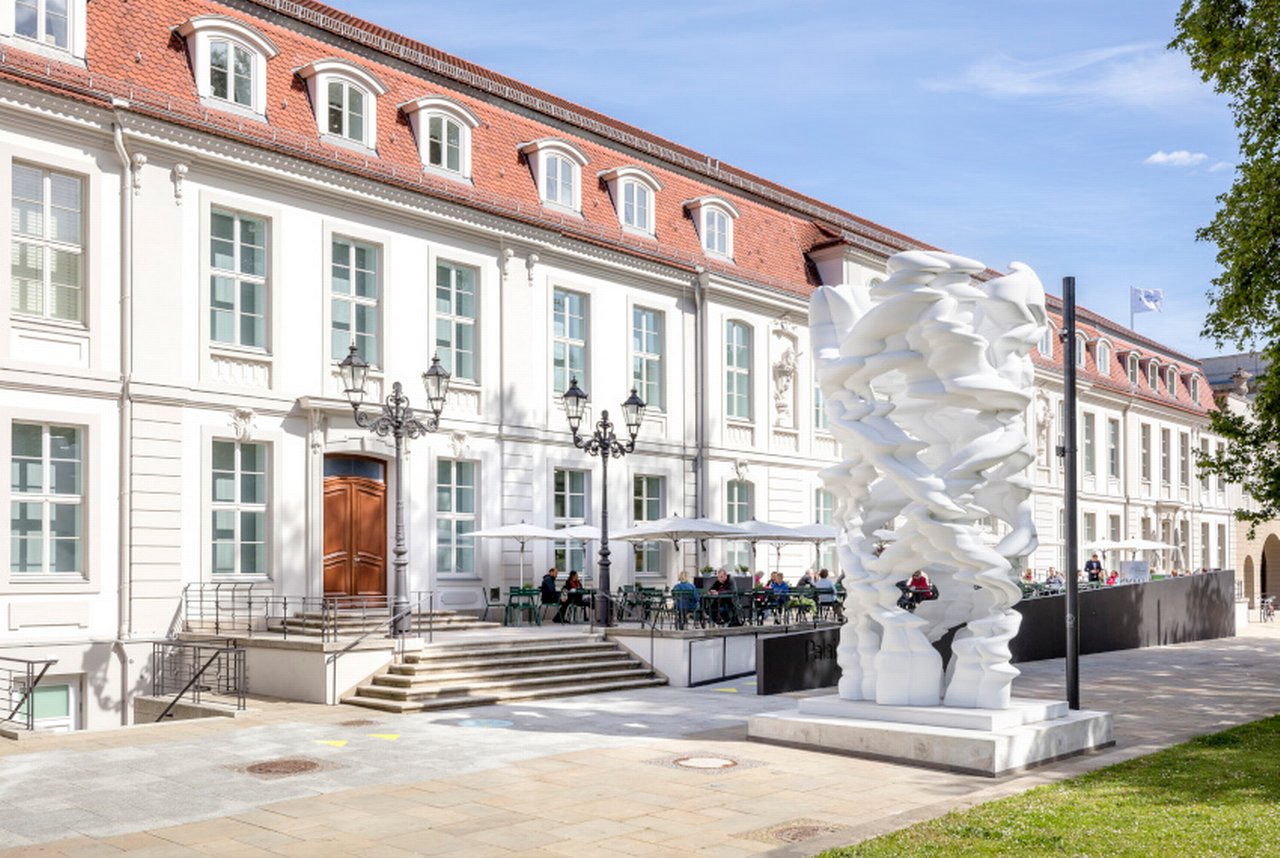SculpturePopulaire
September 2025 – April 2026
Yinka Shonibare: Material (SG) V
The distinctive style of British-Nigerian artist Yinka Shonibare (born 1962) is characterised by his use of vibrantly coloured Dutch wax fabrics. In his multimedia work, including paintings, sculptures, photographs, films, and installations, he explores themes such as postcolonialism, globalisation, class and imperialism. He is particularly interested in the cultural and economic relations between Europe and Africa.
Part of Shonibare’s Wind Sculptures series, Material (SG) V (2025)—installed in front of PalaisPopulaire—features the so-called 'wax print' fabrics, which are considered to be traditionally African. However, these textiles were originally inspired by Indonesian batik, mass produced by the Dutch from the 19th century onward. In the 60s, they were embraced by the African markets and have since come to be regarded as ‘authentically African’ fabrics. They embody cultural hybridity, challenging conventional notions of authenticity, tradition and folklore. This four-metre-high fibreglass sculpture captures a piece of Dutch wax fabric whipped up by the wind, reminiscent of the abstract sculptures of Western post-war modernism influenced by non-European art. Shonibare draws on these connections to modernism and, as a counterpoint to the monolithic, creates something anti-monumental and poetic—forming a dynamic contrast right at Berlin’s Bebelplatz, a site shaped by Prussian influence.
Having studied at Goldsmiths University in London, the artist became known in association with the Young British Artists (YBA) scene. His work was exhibited several times at the Venice Biennale between 2002 and 2024. He has also participated in numerous international exhibitions. In 2019, Shonibare was awarded a CBE (Commander of the British Empire). Deutsche Bank supports Projekt Nexus, a residency and education programme run by the Yinka Shonibare Foundation (Y.S.F.) and the Guest Artists Space (G.A.S.) Foundation. The programme will promote young artistic and creative talent in Nigeria over a period of three years. Works by Yinka Shonibare are part of the Deutsche Bank Collection.
Yinka Shonibare: Material (SG) V, 2025
Steel armature with hand-painted fibreglass resin cast, 400 x 235 x 200 cm, (YS-3514)
© VG Bild-Kunst, Bonn 2025, Courtesy The Artist, Goodman Gallery, South Africa, London, New York; James Cohan Gallery, New York; Stephen Friedman Gallery, London, New York; Photo: Mathias Schormann
Past
2025
Nessi Nezilla: PAPERBOMB
The two-meter-tall sculpture by German-Italian artist Nessi Nezilla (*1990), embodies striking contrasts. A bomb, cast in aluminum yet as light as a feather like paper—resembling an origami work of art. Nezilla plays not only with material but also with scale.
At its core, the work serves as a meditation on the destructive violence of wars, which can erupt anew at any moment, and on the delicate nature of life itself. It stands as a poignant reminder that peace is not a fixed or permanent state, but something that must be actively safeguarded. PAPERBOMB was inspired by the story of the Japanese girl Sadako Sasaki (1943–1955), one of the most well-known survivors of the atomic bombings of Hiroshima and Nagasaki. Only two years old at the time of the bombing, she appeared to grow up healthy and athletic, like many surviving children, until she was diagnosed with leukemia at the age of twelve—a common fate among victims of radiation exposure. According to a Japanese legend, folding 1,000 origami cranes grants a wish from the gods. During her months in the hospital, Sadako folded 1,600 paper cranes before her death. Her story has since become a powerful symbol of the international peace movement and resistance to war.
With this piece, presented as part of the SculpturePopulaire series in the rotunda at PalaisPopulaire, Nezilla has created a work of art that serves both as a warning and a beacon of hope. In its symbolism, PAPERBOMB reminds us that while peace is a fragile state that can be disrupted at any moment, so too can war be brought to an end.
Nessi Nezilla, PAPERBOMB, 2024 © Nessi Nezilla, Photo: Mathias Schormann
2024
Leiko Ikemura: With Blue Birds
Entitled With Blue Birds, the PalaisPopulaire is dedicating a presentation to Leiko Ikemura, which combines sculptural loans with works on paper from the Deutsche Bank Collection in front of the institution and in the rotunda.
Ikemura’s art draws inspiration from old Japanese masters, surrealism, postwar modernism, and the renewed figurative painting of the 1980s. Her work presents hybrid, mythological beings, girls, and women transitioning between human, animal, and plant forms. They explore psychological, social, and spiritual states and the relationship between civilization and nature. The usagi, Japanese for rabbit, first appeared as a central motif in Ikemura's sculptural work in 2011 after the nuclear disaster in Fukushima, evolving from her paintings. This creature with rabbit ears and a human face symbolizes universal mourning, but also resilience and renewal. Ikemura’s figures wear cone-shaped, hollow skirts reminiscent of ritual robes or architecture, addressing the relationship between inner and outer reality. The presentation highlights this dialectic.
On Bebelplatz, the Figure with Three Birds (2021) invites visitors to linger. This round form is echoed in the rotunda inside the building, where the totemic Hare Column III (2021) stands in the center, surrounded by early, rarely shown drawings. The view circles back outside to the other sculpture, offering an almost serene meditation on the delicate state of the world.
Leiko Ikemura, Figure with Three Birds, 2021 © VG Bild-Kunst, Bonn 2024
2023
Erwin Wurm: Tor (Skins)
The artist Erwin Wurm turns the rules of sculpture on their head. Wurm’s performative and ephemeral sculptures are conquering museums, where visitors can make themselves into sculptures with a few banal objects. For all the comedy and punch, it’s about formal questions: What is the object? What is the subject? Wurm experiments with two- and three-dimensionality, with mass, surface, and volume. More iconic works emerged, such as the “fat” cars and single-family houses that look as if they have been blown up.
In his most recent sculptures from the series Skins (2021), one of which is now being presented in front of the PalaisPopulaire as part of SculpturePopulaire, Wurm takes the opposite approach. He radically reduces the volume. His works, which are almost four meters high, look like suit bags or skins from which the bodies have been sucked out. The filigree, fragile-looking sculptures consist of partial casts of living models who bend over, lift, and hold objects. The artist’s relationship to his models is crucial here. In the case of Skins, they include Michael, the artist’s son, and the actor and artist Lars Eidinger, with whom Wurm has worked closely for a long time.
Erwin Wurm, Tor (Skins), 2021 © VG Bild-Kunst, Bonn 2023, Courtesy Thaddaeus Ropac, London/Paris/Salzburg/Seoul, Photo: Mathias Schormann
2022-2023
Bunny Rogers: Techo Statue (turquoise)
Bunny Rogers, born in Houston in 1990, was socialized with the Internet. She grew up in the late 1990s with online communities such as AOL Kids and Second Life, and on the platform Neopets she designed digital figures for the virtual planet Neopia, which is inhabited by Neopets and other creatures.
Her enigmatic sculptures, installations, paintings, performances, and videos made her a shooting star of the young U.S. scene. In them, she conjures up a traumatic teen cosmos that penetrates deep into America’s psyche and social reality.
Her bronze-cast Techo Statue (turquoise), 2021, which will be presented in front of the PalaisPopulaire, was created from Roger’s early designs and ties in to a sense of community and the utopian idea of building new worlds. Yet this work also has the gothic appeal so typical of Rogers, with figures reminiscent of ancient gargoyles.
Bunny Rogers, Techo Statue (turquoise), 2021 © Courtesy the artist, Société, Berlin and Thaddaeus Ropac, London/Paris/Salzburg/Seoul; Photo: Mathias Schormann
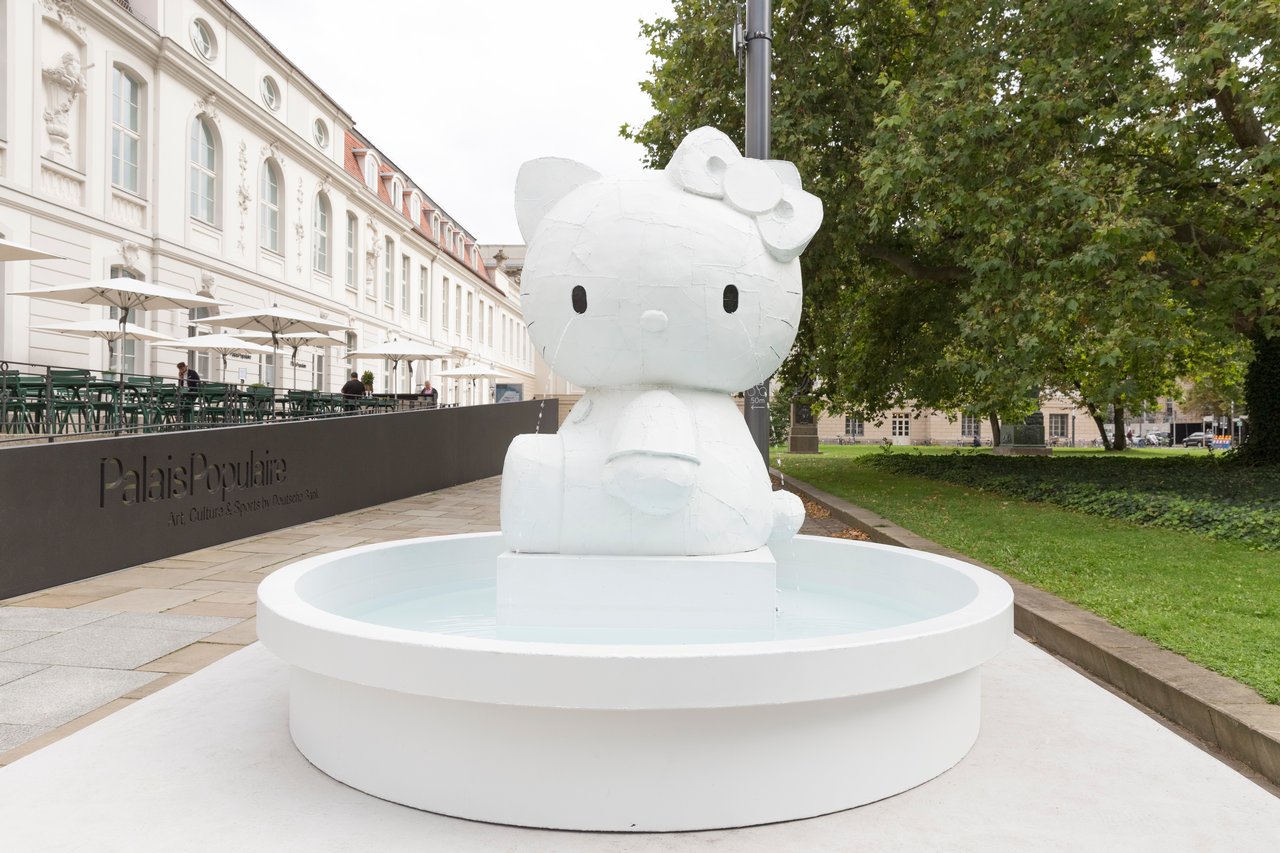
2021-2022
Tom Sachs: Kitty Fountain
Tom Sachs’ three-meter-high Kitty Fountain, cast in bronze, was created in 2008 and was originally part of the monumental sculpture ensemble The Codependent Fountain Tableau. This group of fountain sculptures was installed in the Noguchi Gardens of New York’s Lever House in 2008 and shown in the same year in an exhibition on Place du Trocadéro overlooking the Eiffel Tower in Paris.
For the ensemble, Sachs brought together the iconic children’s characters “Hello Kitty” and “My Melody,” both launched by the Japanese company Sanrio in 1974, with “Miffy,” a small rabbit designed by Dutch author and graphic designer Dick Bruna in 1955. All three characters are mass marketed as merchandising products and are characterized by strong graphic stylization, running counter to the idea of a detailed, classical sculpture.
“Kitty Fountain was invented purely as a merchandising and licensed character,” Sachs said in 2008. “To then redo that in a ‘fine’ material like bronze, I think is really to the point.”
Tom Sachs, Kitty Fountain, 2008 © Tom Sachs, Courtesy Galerie Thaddaeus Ropac, London · Paris · Salzburg · Seoul, Photo: Mathias Schormann
2021
VALIE EXPORT: Die Doppelgängerin
From September 2020, the sculpture Die Doppelgängerin (2010/20) by the Austrian filmmaker, media and performance artist VALIE EXPORT was on view in front of the PalaisPopulaire. Two gigantic scissors are interlocked to form a figure that is both delicate and threatening. The work, which is over four meters high, triggers myriad associations. Traditionally, scissors are associated with sewing, tailoring, and other “feminine” spheres, but also with the male fear of castration and violence with “female” connotations.
Born in 1940, VALIE EXPORT is one of the pioneers of the feminist avant-garde and conceptual media, performance art, and film art. One of the leading representatives of the “European Expanded Cinema” movement, she attempted back in the 1960s to radically push the boundaries of conventional cinema. Time and time again, the artist, born in 1940, has addressed discrimination against women and violence directed against females with hotly debated actions and works such as her famous Tapp- und Tastkino (Tap and Touch Cinema, 1968).
VALIE EXPORT, Die Doppelgängerin, 2010/2020 © VG Bild-Kunst Bonn, 2020, Courtesy the artist and Galerie Thaddaeus Ropac, London · Paris · Salzburg, Photo: Mathias Schormann
2019
Tony Cragg: Runner
Continual change is a constant in the work of Tony Cragg. Almost no other sculptor has given bronze, high-grade steel, stone, and plastic such dynamic elegance. So far, he has received the Turner Prize and the Praemium Imperiale for his work. His almost six-meter-high sculpture Runner (2017) was installed in front of the PalaisPopulaire in Berlin in April 2019.
The sculptor, who was born in Liverpool and has lived in Wuppertal since 1977, is one of the key artists in the Deutsche Bank Collection. At an early stage, the bank collected many of Cragg’s works on paper. His monumental sculpture Secretions (1998), composed of thousands of dice, has a prominent place at Deutsche Bank’s London headquarters.
Tony Cragg, Runner, 2017 © VG Bild-Kunst 2020, Photo: David von Becker

